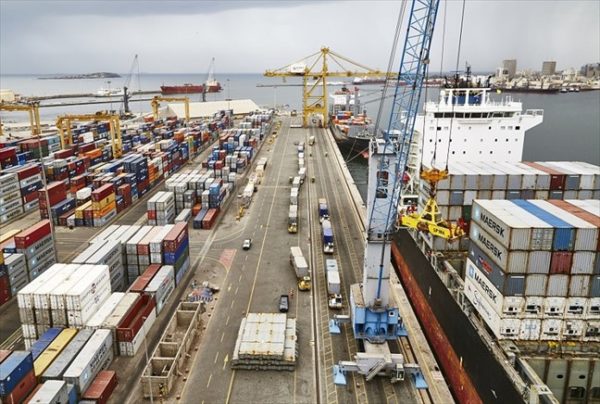In the first quarter of 2025, Senegal’s trade deficit decreased by 305.5 billion CFA francs (550 million dollars), according to data from the Direction of Forecasting and Economic Studies (DPEE) based in Dakar.
This trade deficit stands at 238.9 billion CFA francs, due to the increase in goods exports (+173.3 billion) combined with a decrease in imports (-150.2 billion). “Thus, as highlighted by the DPEE in its conjuncture note, during this period, the import coverage rate by exports is estimated at 85.5% compared to 69.0% the previous month.”
During the first quarter of 2025, goods exports are estimated by the DPEE at 1,386.1 billion CFA francs, recording an increase of 14.3% (+173.3 billion) compared to the last quarter of 2024. “This increase is mainly attributable to the increase in sales of crude oil (+144.6 billion), fresh vegetables (+19.3 billion), mineral and chemical fertilizers (+16.6 billion), and crude gold (+10.5 billion),” the DPEE points out. It adds that the increase in sales of crude oil and mineral and chemical fertilizers is explained, respectively, by the simultaneous increase in quantities sold (+35.2%; +5.9%) and implicit prices (+683.0%; +10.3%). As for the increase in sales of fresh vegetables, it is due to the expansion of the quantity exported (+648.6%), although the implicit price decreased by 31.4%.
Regarding gold, the increase in sales is linked to a 6.5% increase in the implicit price, despite a slight decrease in shipped quantities of 0.5%. However, the increase in goods exports was mainly hindered by the decline in sales of phosphoric acid (-14.1 billion), titanium (-11.1 billion), and soup, broth, and bouillon preparations (-8.9 billion). The decrease in sales of titanium and soup, broth, and bouillon preparations is attributed to the simultaneous decrease in quantities sold and implicit prices, respectively, by (-37.6%; -4.2%) and (-30.7%; -2.1%). Furthermore, the decline in phosphoric acid shipments is linked to a 20.1% slowdown in the quantity sold, with the implicit price increasing by 0.8%.
On an annual basis, Senegal’s goods exports increased by 60.2% (+521.0 billion) to stabilize at 1,386.1 billion, mainly due to the increase in sales of crude oil (+472.5 billion) and crude gold (+69.0 billion). The increase in crude oil shipments, on the other hand, is attributable to the strengthening of quantities sold, despite a decline in implicit prices of 30.4%. As for the increase in sales of crude gold, it is linked to both the growth in quantities sold and implicit prices (+12.9%; +40.8%). However, the increase in goods exports was slowed down mainly by the decrease in sales of peanut products (-58.1 billion) and hydraulic cement (-13.8 billion). The decline in sales of peanut products and hydraulic cement, according to the DPEE, is due to the decrease in quantities exported, respectively, by 98.8% and 33.4%, despite the increase in their implicit prices, which increased by 69.2% and 5.4%.
What about imports in the first quarter of 2025? On this point, the DPEE reports that they decreased by 9.9% (-150.2 billion) on a quarterly basis, amounting to 1,846.6 billion. “This contraction is mainly due to the decrease in purchases of machinery, equipment, and engines (-48.7 billion), vehicles, transport equipment, and automotive parts (-32.7 billion), and finished petroleum products (-23.0 billion),” notes the DPEE. The decrease in imports of machinery, equipment, and engines and finished petroleum products results from a simultaneous contraction in their imported quantities and implicit prices, respectively, by (-6.4%; -12.5%) and (-3.5%; -2.9%). As for the decline in purchases of vehicles, transport equipment, and automotive parts, it is due to the decrease in ordered quantities by 26.6%, despite an increase in implicit prices by 23.1%. However, the decline in goods imports was mitigated mainly by the increase in orders for crude oil (+18.5 billion) and rice (+5.3 billion), linked to an increase in both quantities purchased and implicit prices, respectively, by (+12.4%; +1.3%) and (+3.3%; +2.5%).
On an annual basis, goods imports increased from 1,679.9 billion CFA francs to 1,846.6 billion CFA francs, an increase of 166.7 billion. This increase in goods purchases is mainly attributed to the increase in orders for vehicles, transport equipment, and automotive parts (+179.3 billion) and crude oil (+48.9 billion). The increase in imports of vehicles, transport equipment, and automotive parts is due to the simultaneous increase in imported quantities and implicit prices (+61.9%; +0.1%). As for the increase in orders for crude oil, it is linked to the increase in quantities purchased by 49.9%, despite a decrease in implicit prices by 2.0%. Furthermore, imports of finished petroleum products and machinery, equipment, and engines decreased by 32.7 billion and 18.9 billion, respectively. Regarding the decrease in imports of finished petroleum products, the DPEE emphasizes that it is due to a 13.5% decrease in the implicit price, despite the increase in ordered quantities by 5.5%. As for the decrease in purchases of machinery, equipment, and engines, it is due to the simultaneous decrease in purchased quantities by 0.7% and implicit prices by 7.3%.


